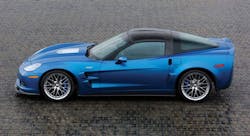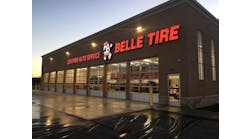More than 115 years after John Seiberling patented a puncture-resistant tire, the automotive industry is still trying to develop a maintenance-free tire. Run-flat tires offer a short-term solution; they aren’t puncture proof, but you can drive on them without air and without damaging the wheel.
However, the trade-off is at least twofold: a harsher ride and, when the consumer is ready to replace them, sticker shock.
Tire and vehicle manufacturers are trying to solve the problems. Bridgestone Corp. says its third-generation run-flat tires will “further improve ride comfort” with the help of new sidewall-reinforced rubber that reduces heat generation. In addition, the company’s “Cooling Fin” technology uses protrusions facing the center of the wheel to create disturbances in air flow.
The cooler-running tires “can reduce vertical stiffness deflection... and achieve riding comfort comparable to conventional tires,” according to Bridgestone.
The new run-flats will be introduced as original equipment fitments later this year.
Targeting the OE market has been a major goal of run-flat tire manufacturers for years. Will run-flats take over the OE segment in the near future? No, says Mike Martini, president of the consumer OE division of Bridgestone Americas Inc. Run-flats at OE are not going to dramatically increase.
“The number one issue with the original equipment manufacturers is fuel economy, and while our run-flat tires are approaching the rolling resistance capabilities of conventional tires, they are still not totally equal.
“So in the short term, the OE specifications that are created from the CAFE (Corporate Average Fuel Economy) regulations will not help our push for run-flat tires.”
“They won’t take over,” says Tom Chubb, vice president of OE for Michelin North America Inc. “We still see a limited amount of interest in the self-supporting run-flats.
“There are some specialty vehicle applications, like the Corvette ZR1, but they don’t represent the mainstream.”
The popularity of smaller vehicles and hybrids with alternative power trains is causing the car companies to look for ways to eliminate the spare tire, according to Chubb.
“When vehicle downsizing takes place, or vehicles use alternative power trains that require batteries, designers have to be more concerned with interior space. If you put these two things together, the space taken up by the spare tire becomes more valuable.”
Bill Bainbridge, director of brand communication for Hankook Tire America Corp., says run-flat tires have lost momentum at both the OE and replacement levels.
“We don’t see run-flats taking on much more share of market in OE or replacement. We have the technology in place and, in fact, do have tires in production that are being sold in Europe, but none here in North America.”
Bainbridge says vehicle manufacturers like run-flat technology, but not the corresponding rise in rolling resistance compared to conventional tires. “Especially in the U.S., with mainstream OE fitments, lowering rolling resistance wins almost every time.”
“Even though there are clear technical advantages to the run-flat tires, we do not see many of our OEM customers taking the next step to ensure a strong growth of the run-flat market,” says Bill Caldwell, vice president of original equipment, Americas Division, for Continental Tire North America Inc.
Mark Chung, Yokohama Tire Corp.’s director of corporate strategy and planning, has a slightly different view.
“I believe the case for OEMs using more run-flats is strong, given that the downsizing of vehicles — inevitable once gas prices escalate again — will make the task of increasing vehicle interior space and weight reduction a very difficult and costly task,” he says. “Run-flats are an easy solution to this dilemma.
“This, however, will need to be balanced with customers’ expectations with ride comfort and product availability once the need for replacement arises.”
Ride comfort and other issues
Like Bridgestone, both Yokohama Tire Corp. and Goodyear Tire & Rubber Co. are trying to address run-flat performance weaknesses.
“Yokohama is strongly considering the opportunity to bring to market a unique run-flat tire that will not only deliver spirited performance, but also one that addresses the comfort aspect as well,” says Chung.
When Goodyear unveiled its next generation RunOnFlat tire in Europe last year, it said new technology provided “improved driving comfort, increased fuel economy, reduced mass and rolling resistance in addition to reduced CO2 emission levels.” It also is developing an “ultra low rolling resistance” RunOnFlat tire with environmentally friendly materials.
Toyo Tire U.S.A. Corp. has noticed a lot of indifference to run-flat tires in the replacement market.
“Right now, we don’t see a significant replacement demand for these tires,” says Dave Taylor, Toyo’s vice president, technical services. “On the contrary, consumers seem to be opting out at replacement time and mounting conventional tires, although this practice — without a spare tire — may not be the best practice.”
Taylor says consumers don’t embrace run-flats tires for many reasons.
• They are difficult to find on the replacement market. “Few dealers stock them,” he says.
• They are expensive.
• “Most models” cannot be repaired.
• They ride rough.
• They tend to generate pattern noise as they wear.
• “Long tread wear does not seem to be a characteristic of these tires.”
• The special mounting/demounting equipment may not be found at all tire shops.
“Over time,” says Taylor, “auto makers will have to decide if the sacrifice in consumer satisfaction and the potential future improvements in run-flat tire technology will be worth the extension of run-flat fitments for future models.” ■
Emerging no more? J.D. Power drops run-flat tires from surveys
Every year, J.D. Power and Associates studies consumer perceptions of “emerging technologies” in the domestic automotive industry. In 2005, run-flat tires ranked first in interest, ahead of night vision systems and stability control. When a market price of $600 was factored in, run-flats fell to fourth, behind stability control, premium surround sound and HD radio.
In 2006, run-flats placed second (behind side impact airbag protection) and seventh, respectively. They rebounded in 2007, once again ranking first in general interest, and third when market price was taken into consideration.
However, in the 2008 and 2009 surveys, run-flat tires were not listed. Mike Marshall, director of automotive emerging technologies, says the OEMs and tier one and tier two suppliers that J.D. Power solicits to build the survey lists didn’t consider run-flats a high priority.
“In 2008 (and 2009), there were relatively more features that garnered higher interest among our client base for gauging consumer interest and feature functionality.”




